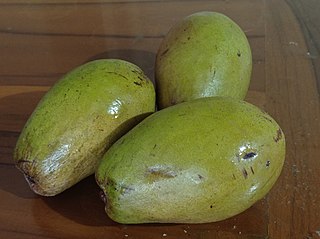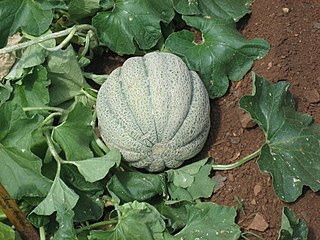Related Research Articles

A plum is a fruit of some species in Prunus subg. Prunus. Dried plums are often called prunes, though in the United States they may be labeled as 'dried plums', especially during the 21st century.

Dimocarpus longan, commonly known as the longan and dragon's eye, is a tropical tree species that produces edible fruit. It is one of the better-known tropical members of the soapberry family Sapindaceae, to which the lychee and rambutan also belong. The fruit of the longan is similar to that of the lychee, but is less aromatic in taste.

The cantaloupe is a type of true melon with sweet, aromatic, and usually orange flesh. Originally, cantaloupe refers to the true cantaloupe or European cantaloupe with non- to slightly netted and often ribbed rind. Today, it also refers to the muskmelon with strongly netted rind, which is called cantaloupe in North America, rockmelon in Australia and New Zealand, and spanspek in Southern Africa. Cantaloupes range in mass from 0.5 to 5 kilograms.

A melon is any of various plants of the family Cucurbitaceae with sweet, edible, and fleshy fruit. The word "melon" can refer to either the plant or specifically to the fruit. Botanically, a melon is a kind of berry, specifically a "pepo". The word melon derives from Latin melopepo, which is the latinization of the Greek μηλοπέπων (mēlopepōn), meaning "melon", itself a compound of μῆλον (mēlon), "apple", treefruit " and πέπων (pepōn), amongst others "a kind of gourd or melon". Many different cultivars have been produced, particularly of cantaloupes.

Guava is a common tropical fruit cultivated in many tropical and subtropical regions. The common guava Psidium guajava is a small tree in the myrtle family (Myrtaceae), native to Mexico, Central America, the Caribbean and northern South America. The name guava is also given to some other species in the genus Psidium such as strawberry guava and to the pineapple guava, Feijoa sellowiana. In 2019, 55 million tonnes of guavas were produced worldwide, led by India with 45% of the total. Botanically, guavas are berries.

Momordica charantia is a tropical and subtropical vine of the family Cucurbitaceae, widely grown in Asia, Africa, and the Caribbean for its edible fruit. Its many varieties differ substantially in the shape and bitterness of the fruit.

Benincasa hispida, the wax gourd, also called ash gourd, white gourd, winter gourd, winter melon, tallow gourd, ash pumpkin, Chinese preserving melon, is a vine grown for its very large fruit, eaten as a vegetable when mature. It is the only member of the genus Benincasa.

Cucumis metuliferus, commonly called the African horned cucumber, horned melon, spiked melon, jelly melon, or kiwano, is an annual vine in the cucumber and melon family Cucurbitaceae. Its fruit has horn-like spines, hence the name "horned melon". The ripe fruit has orange skin and lime-green, jelly-like flesh. C. metuliferus is native to Southern Africa, in South Africa, Namibia, Botswana, Zambia, Malawi, Zimbabwe, Mozambique, and Angola.

A pumpkin seed, also known as a pepita, is the edible seed of a pumpkin or certain other cultivars of squash. The seeds are typically flat and oval with one axis of symmetry, have a white outer husk, and are light green after the husk is removed. Some pumpkin cultivars are huskless and are grown only for their edible seed. The seeds are nutrient- and calorie-rich, with an especially high content of fat, protein, dietary fiber, and numerous micronutrients. Pumpkin seed can refer either to the hulled kernel or unhulled whole seed and most commonly refers to the roasted end product used as a snack.

The honeydew melon is one of the two main cultivar types in Cucumis melo Inodorus Group. It is characterized by the smooth, often green or yellowish rind and lack of musky odor. The other main type in the Inodorus Group is the wrinkle-rind casaba melon.

Mangifera caesia is a species of flowering plant in the cashew family, Anacardiaceae. Known in English as jack or white mango, among other names. It belongs to the same genus as the mango and is widely cultivated in areas of Indonesia, Malaysia, Singapore, Brunei, Papua New Guinea and the Philippines.

The Hami melon is an umbrella term for sweet melon varieties from Xinjiang, China, especially from Hami. It is also referred to as the Chinese Hami melon or the snow melon. The outer color is generally white through pink or yellow through green. The inside flesh is sweet and crisp.

The Santa Claus melon, sometimes known as Christmas melon or Piel de Sapo, is a variety of melon originating in Spain that grows to about a foot in length and is ovoid in shape. It has a thick, green-striped outer rind and pale green to white inner flesh with a mild melon flavour and sweetness close to honeydew melons.
The sprite melon is a kind of melon, similar to honeydew, which originates from Japan. Since the late 1990s, it has been cultivated in North Carolina as a specialty crop and has increased in popularity in recent years. it has been cultivated and developed throughout history by selective breeding into the modern melon we have today.

A pitaya or pitahaya is the fruit of several cactus species indigenous to the region of southern Mexico and along the Pacific coasts of Guatemala, Costa Rica, and El Salvador. Pitaya is cultivated in East Asia, South Asia, Southeast Asia, the United States, the Caribbean, Australia, Brazil, and throughout tropical and subtropical regions of the world.

Watermelon is a flowering plant species of the Cucurbitaceae family and the name of its edible fruit. A scrambling and trailing vine-like plant, it is a highly cultivated fruit worldwide, with more than 1,000 varieties.

Cucumis melo, also known as melon, is a species of Cucumis that has been developed into many cultivated varieties. The fruit is a pepo. The flesh is either sweet or bland, with or without an aroma, and the rind can be smooth, ribbed, wrinkled, or netted. The species is sometimes referred to as muskmelon, but there is no consensus about the usage of this term, as it can also be used as a specific name for the musky netted-rind American cantaloupe, or as a generic name for any sweet-flesh variety such the inodorous smooth-rind honeydew melon.

The oriental melon, is a group of Cucumis melo cultivars that are produced in East Asia. Phylogenetic studies tracing the genetic lineage of the plant suggest that it may have originated in eastern India, having then spread to China over the Silk Road, from which it was introduced to Korea and Japan. Its flavour has been described as a cross between a honeydew melon and a cucumber. It is noticeably less sweet than Western varieties of melon, and consists of about 90% water. The fruits are commonly eaten fresh; with its thin rind and small seeds, the melon can be eaten whole.
Longan wine is a Southeast Asian fermented drink made of the fruit of Dimocarpus longan, more commonly called longan or dark-skinned dragon's eye. While originating in China, it has also become a speciality in a number of locations in Southeast Asia such as the Vietnamese province of Bac Lieu.
Pepitada is a beverage traditionally consumed by Sephardic Jews in parts of the Eastern Mediterranean, including Greece, Bulgaria, and Turkey, as a way to break the Yom Kippur fast. Prepared from toasted melon seeds, it is a sweet, milky beverage.
References
- ↑ "China Specialty & Snack". Specialty & Snack. 2007. Retrieved 2009-06-10.
- 1 2 Lim, T.K. (2012). Edible Medicinal And Non-Medicinal Plants: Volume 2, Fruits. Dordrecht: Springer. p. 214. ISBN 9789400717633.
- 1 2 USA, Best Nutrition Products Inc. Hayward, CA. "The honeydew melon is almost perfectly round with a smooth, waxy white skin, Dr.Abhay Kumar Pati USA". PRLog. Retrieved 2018-07-06.
{{cite web}}: CS1 maint: multiple names: authors list (link) - ↑ Zhao, Rongguang (2015). A History of Food Culture in China. New York: SCPG Publishing Corporation. p. 110. ISBN 9781938368271.
- ↑ Gómez-García, Ricardo (May 2020). "Valorization of melon fruit (Cucumis melo L.) by-products: Phytochemical and Biofunctional properties with Emphasis on Recent Trends and Advances". Trends in Food Science & Technology. 99: 507–519. doi:10.1016/j.tifs.2020.03.033. S2CID 216195115 – via Science Direct.
